History
Constructed between 1530 and 1540 by Luca Grimaldi, a member of the House of Grimaldi, one of the most important Genoese families, in 1658 the palace passed into the possession of the De Franchi Toso family, and in 1711 it was given by its inheritor Federico de Franchi Toso, to Maria Durazzo Brignole-Sale, his main creditor.
The new owners, between 1714 and 1716, carried out a decisive restoration of the building, adapting it to the tastes of the age. It subsequently earned the name White for the clear color of its exterior decoration.
In 1899, Maria Brignole Sale, the Duchess of Galliera and the last member of the family, divested the palace to become municipal property and thus destined it to become a public gallery.
The gallery
"For the formation of a public gallery": with these words, in her testament of 1884, the Duchess dedicated the Gallery of the Palace as a public space, with the intention to increase its collection yet further. This constituted the first nucleus of the civic museum.
After 1887, the gallery was enriched by the purchase of numerous private collections. It has since benefited from a transformation due to reordering of the collections and the post-war reconstruction of the palace, curated by Orlando Grosso, Caterina Marcenaro and the architect Franco Albini, and from the inward transfer of sculpture and fresco from other museums and galleries.
The gallery offers a panorama of European painting from the 12th century to the 17th century, with a large prevalence of Genoese, Flemish, French and Spanish painters. Of the 13th and 16th century, works are shown by authors such as Barnaba da Modena, Ludovico Brea and Luca Cambiaso (including La Madonna della candela). 16th-century paintings include work by Paolo Veronese from the Venetian school, and Filippino Lippi of Florence. Dutch and Flemish paintings from the 16th to 18th century feature Rubens (including Venus and Mars) and Van Dyck (including Vertummo and Pomona). Notable Spanish artists of the 17th century included are Zurbarán, Murillo and Ribera.
The activity of the Genoese painters of the 17th and 18th centuries is documented from the works of Giovanni Benedetto Castiglione, Giovanni Andrea Ansaldo, Bernardo Strozzi, Valerio Castello, Domenico Piola, Paolo Girolamo Piola, Gregorio De Ferrari and Alessandro Magnasco.

Ecce Homo is a painting of the moment known as Ecce Homo from the Passion of Jesus by the Italian Baroque master Caravaggio. It is now in the Palazzo Bianco, Genoa, Italy. Contemporary accounts claim the piece was part of an unannounced competition between three artists, and that the Caravaggio version was eventually sent to Spain.

Gioacchino Assereto was an Italian painter of the early Baroque period and one of the most prominent history painters active in Genoa in the first half of the 17th century.

Domenico Piola was a Genoese painter of the Baroque period. He was the leading artist in Genoa in the second half of the 17th century, working on ceiling frescoes for many Genoese churches and palaces and canvas paintings for private collectors. His family studio was highly prolific and frequently collaborated with other artists.
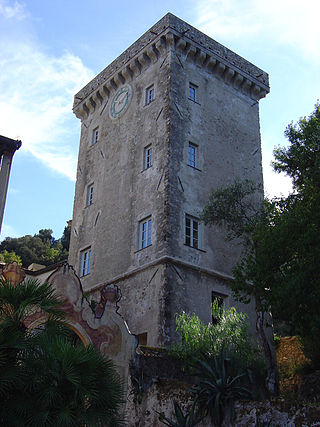
Cervara Abbey is a former abbey in Santa Margherita Ligure, Liguria region, northern Italy. It is on the coastal road to Portofino. The abbey complex is a designated National Monument of Italy.

The Palazzo Brignole Sale or Palazzo Rosso is a house museum located in Via Garibaldi, in the historical center of Genoa, in Northwestern Italy. The palace is part of the UNESCO World Heritage Site Genoa: Le Strade Nuove and the system of the Palazzi dei Rolli. The rich art collection inside, along with the galleries of Palazzo Bianco and Palazzo Doria Tursi, is part of the Musei di Strada Nuova and consists of the works of artists of the caliber of Antoon van Dyck, Guido Reni, Paolo Veronese, Guercino, Gregorio De Ferrari, Albrecht Dürer, Bernardo Strozzi and Mattia Preti.

Genoa: Le Strade Nuove and the system of the Palazzi dei Rolli is a UNESCO World Heritage Site which includes a number of streets and palaces in the center of Genoa, in Northwestern Italy.

Genoa is a city in and the capital of the Italian region of Liguria, and the sixth-largest city in Italy. In 2023, 558,745 people lived within the city's administrative limits. While its metropolitan city has 813,626 inhabitants, more than 1.5 million people live in the wider metropolitan area stretching along the Italian Riviera.

The Palazzo Spinola di Pellicceria, also known as Palazzo Francesco Grimaldi, is a palace located in piazza di Pellicceria in the historical center of Genoa, Northwestern Italy. The palace was one of the 163 Palazzi dei Rolli of Genoa, the selected private residences where the notable guests of the Republic of Genoa were hosted during State visits. On 13 luglio del 2006 it was added to the list of 42 palaces which now form the UNESCO World Heritage Site Genoa: Le Strade Nuove and the system of the Palazzi dei Rolli. It is currently owned by the Ministry of Cultural Heritage and Activities and Tourism and houses the National Gallery of Art in Palazzo Spinola.
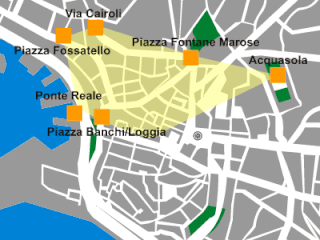
Maddalena is a neighbourhood in the old town of the Italian city of Genoa. It was one of the six sestieri of ancient Genoa. At present it is part of the Genoa's city Municipio I.

The Cervara Altarpiece or Cervara Polyptych was an oil-on-oak-panel altarpiece painted by the Flemish painter Gerard David early in the 16th century for the high altar of Cervara Abbey in Liguria, Italy.
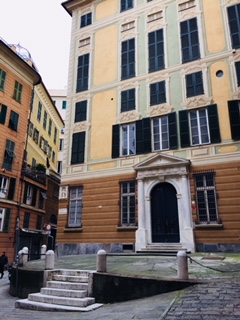
The Palazzo Clemente della Rovere is a palace located in Piazza Rovere in the historical center of Genoa, Northwestern Italy. The palace was one of the 163 Palazzi dei Rolli of Genoa, the selected private residences where the notable guests of the Republic of Genoa were hosted during State visits. On 13 luglio 2006 it was added to the list of 42 palaces which now form the UNESCO World Heritage Site Genoa: Le Strade Nuove and the system of the Palazzi dei Rolli. The palace hosts today the General Consulate of Iceland.
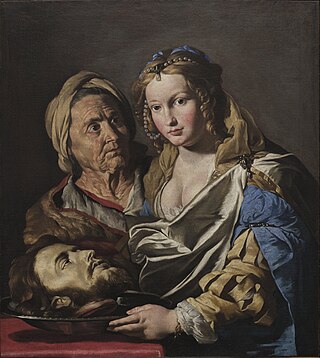
Salome with the Head of John the Baptist is an oil on canvas painting by the 17th century painter Matthias Stom. It is now in the Palazzo Bianco of the Musei di Strada Nuova in Genoa, to whose collections it was left in 1926 by E. L. Peirano. Typically of the painter's style, it combines Flemish attention to detail with the lessons he had learned from Caravaggio's work.

The Musei di Strada Nuova in the Italian city of Genoa comprise three museums which together form a single complex, housed in the Palazzo Rosso, the Palazzo Bianco and the Palazzo Tursi, all of which are located along the Via Garibaldi. The Palazzo Tursi is also Genoa's city hall.

Woman Cooking or The Cook is the modern title given to a circa 1625 oil on canvas genre painting by Bernardo Strozzi, produced in Genoa and still held in the Palazzo Rosso in the city, part of the Strada Nuova Museums. A second autograph version with various differences was in the painter's studio at his death and is now at the National Gallery of Scotland in Edinburgh.

Maria Brignole Sale De Ferrari, Duchess of Galliera was an Italian noblewoman and philanthropist. She enabled the foundation of the first museums in her birthplace of Genoa, the Palazzo Rosso and Palazzo Bianco as well as the Galliera Hospital and the San Filippo children's hospital. A statue of her by Giulio Monteverde stands in the hospital gardens.

The palazzo Doria-Tursi or palazzo Niccolò Grimaldi is a building on Via Giuseppe Garibaldi in the historic town centre of Genoa. With Palazzo Rosso and Palazzo Bianco it houses the Strada Nuova Museums and on 13 July 2006 all three palaces and the streets around them became the Genoa: Le Strade Nuove and the system of the Palazzi dei Rolli World Heritage Site. Since 1848 Palazzo Doria-Tursi has also housed the city hall of Genoa.

The Dying Cleopatra or The Death of Cleopatra is a c. 1648 oil on canvas painting by Guercino, now in the Palazzo Rosso in Genoa.

Palazzo Durazzo-Pallavicini or Palazzo di Gio Agostino Balbi is a building on Via Balbi in the historic city centre of Genoa. On 13 July 2006 it became one of 42 palazzi included in the new Palazzi dei Rolli World Heritage Site.
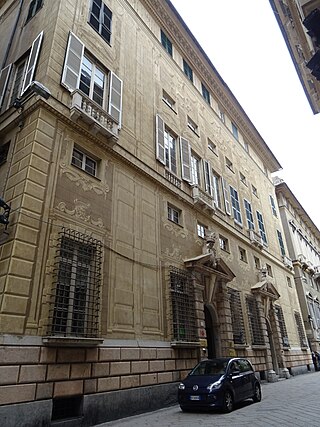
The palazzo Cattaneo-Adorno or palazzo Lazzaro e Giacomo Spinola is a building located on via Garibaldi, in the historical centre of Genoa, marked by house numbers 8 and 10, included on 13 July 2006 in the list of 42 palaces inscribed in the Rolli di Genova, which became World Heritage by UNESCO on that date. It houses a remarkable cycle of Baroque frescoes by Lazzaro Tavarone.

The palazzo Bernardo e Giuseppe De Franchi Toso is a building located in Piazza della Posta Vecchia at number 2 in historic centre of Genoa. The building was included in the list of palaces inscribed in the Rolli di Genova. It was an important seat of the Italian Socialist Party from 1952 to 2003.




















